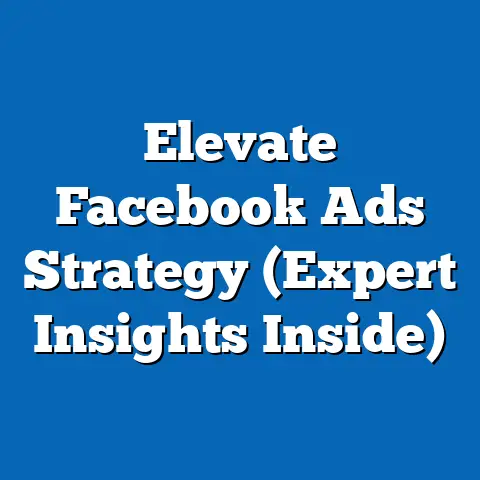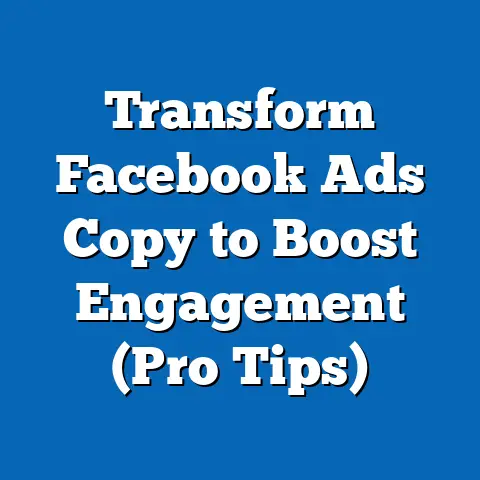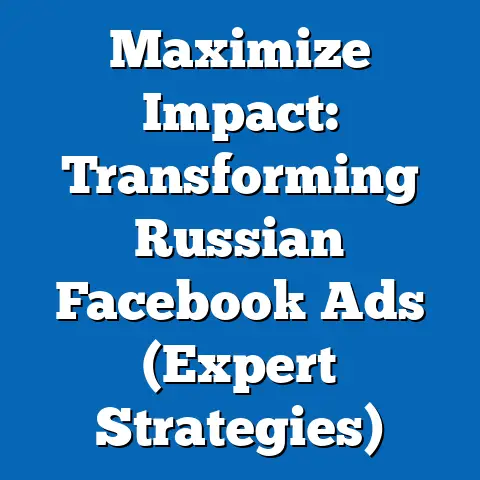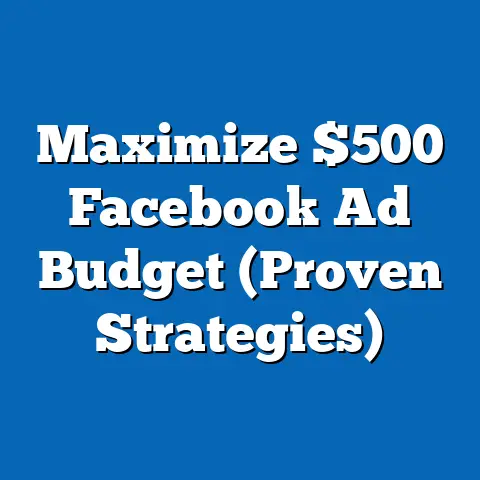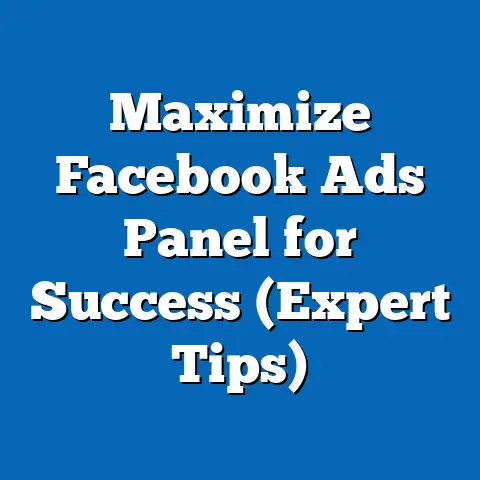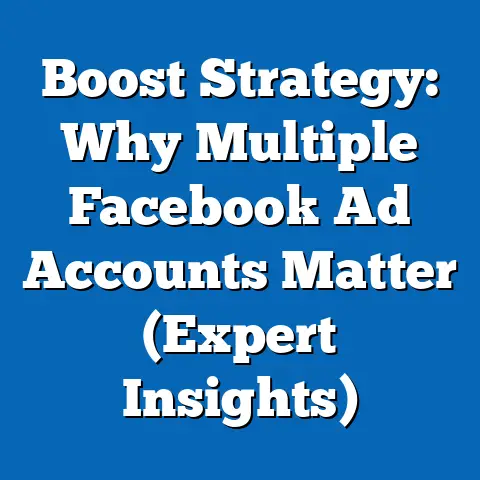Pregnancy in Facebook Ads (Unlocking Creative Potential)
The first time I saw a positive pregnancy test, my world shifted. It wasn’t just a change; it was a complete, overwhelming transformation. Suddenly, every decision, every thought, every dream revolved around this tiny human growing inside me. I remember the whirlwind of emotions – joy, fear, anticipation, and a deep, almost primal love. That’s the power of pregnancy. It’s not just a physical state; it’s an emotional odyssey.
Section 1: Understanding the Pregnancy Niche in Advertising
The pregnancy niche on Facebook isn’t just another demographic; it’s a vibrant, engaged community of individuals undergoing a profound life transition. Understanding this niche requires more than just surface-level knowledge; it demands empathy, insight, and a deep appreciation for the complexities of the pregnancy journey.
Defining the Pregnancy Niche
Within the vast landscape of Facebook advertising, the pregnancy niche encompasses a diverse range of products and services tailored to expectant parents, new parents, and families. This includes everything from prenatal vitamins and maternity wear to baby gear, childcare services, and educational resources.
Why is this niche so significant? Because pregnancy is a pivotal moment of change, marked by heightened consumer activity and a willingness to invest in products and services that support the well-being of both mother and child. Expectant parents are actively seeking information, advice, and solutions to navigate the challenges and joys of parenthood.
Targeting Expectant Parents and Families
Facebook’s robust targeting capabilities make it an ideal platform for reaching expectant parents. I remember being bombarded with ads for baby products as soon as I updated my relationship status to “expecting.” It was a little overwhelming, but it also showed me the power of Facebook’s algorithms.
Demographic Insights:
- Age: Target individuals aged 25-40, as this is the most common age range for first-time parents.
- Location: Focus on geographic areas with higher birth rates and family-friendly amenities.
- Income: Tailor your messaging and product offerings to different income levels.
Behavioral Trends:
- Interests: Target users who have expressed interest in pregnancy-related topics, such as parenting blogs, baby products, and fertility services.
- Life Events: Utilize Facebook’s “Life Events” targeting to reach individuals who have recently announced their pregnancy or are engaged.
- Purchase Behavior: Target users who have previously purchased baby products or maternity wear online.
Stages of Pregnancy and Advertising Opportunities
Pregnancy is not a monolithic experience; it unfolds in distinct stages, each presenting unique advertising opportunities.
- First Trimester (Weeks 1-13): Focus on products that address early pregnancy symptoms, such as morning sickness remedies, prenatal vitamins, and comfortable clothing. Messaging should be sensitive and supportive, acknowledging the challenges of early pregnancy.
- Second Trimester (Weeks 14-27): Highlight baby gear, nursery furniture, and educational resources. This is a good time to promote ultrasound services and gender reveal parties. Ads should be visually appealing and focus on the excitement of preparing for a new baby.
- Third Trimester (Weeks 28-40): Promote products that support late-stage pregnancy comfort, such as maternity pillows, stretch mark creams, and breastfeeding supplies. This is also a good time to advertise birth classes and postpartum support services. Messaging should be reassuring and focus on the upcoming arrival of the baby.
Key Statistics
- According to Statista, the global baby care market is projected to reach \$88.72 billion in 2024.
- A Nielsen study found that 83% of new moms use social media for parenting advice and product recommendations.
- Facebook reports that over 1.4 million users are actively engaged in pregnancy-related groups and pages.
Takeaway: Understanding the nuances of the pregnancy niche is crucial for crafting effective Facebook ad campaigns. By targeting the right audience, tailoring your messaging to specific stages of pregnancy, and leveraging key statistics, you can maximize your advertising ROI and build meaningful connections with expectant parents.
Section 2: Emotional Resonance in Ads
I’ve always believed that the best advertising doesn’t just sell products; it tells stories. And when it comes to pregnancy, the stories are already there – stories of hope, love, and transformation. Tapping into these emotions is the key to creating Facebook ads that truly resonate with expectant parents.
The Importance of Emotional Storytelling
Emotional storytelling is the art of crafting narratives that evoke feelings and create a connection between your brand and your audience. In the pregnancy niche, this means understanding the emotional landscape of expectant parents and reflecting their experiences in your ads.
Why is emotional storytelling so effective? Because pregnancy is an inherently emotional experience. Expectant parents are navigating a complex mix of joy, anxiety, excitement, and uncertainty. Ads that acknowledge these emotions and offer solutions or support are more likely to capture their attention and build trust.
Examples of Successful Emotionally-Driven Campaigns
- Pampers’ “Love at First Sight” Campaign: This campaign features heartwarming videos of parents meeting their newborns for the first time. The focus is on the unconditional love and connection between parent and child, rather than the features of the diapers themselves.
- Dove’s “Real Moms” Campaign: This campaign celebrates the diversity of motherhood and challenges unrealistic expectations. The ads feature real moms sharing their experiences and struggles, creating a sense of authenticity and relatability.
- Johnson’s Baby’s “Promise” Campaign: This campaign focuses on the promises parents make to their children, such as protecting them, nurturing them, and helping them grow. The ads evoke feelings of love, hope, and commitment, reinforcing the brand’s message of trust and care.
The Psychology Behind Emotionally-Driven Ads
- Mirror Neurons: These neurons in our brains allow us to empathize with others by mirroring their emotions. When we see an ad that reflects our own experiences and feelings, it activates these neurons and creates a sense of connection.
- Oxytocin: This hormone is associated with bonding and trust. Emotional ads that evoke feelings of love and connection can trigger the release of oxytocin, making us more receptive to the brand’s message.
- Memory Encoding: Emotional experiences are more likely to be encoded into long-term memory. This means that emotionally-driven ads are more likely to be remembered and have a lasting impact on brand perception.
Creating Relatable Narratives
- Understand Your Audience: Conduct thorough research to understand the specific needs, fears, and aspirations of your target audience.
- Focus on the “Why”: Don’t just talk about the features of your product; explain how it will improve the lives of expectant parents.
- Use Authentic Voices: Feature real parents in your ads and let them share their own stories.
- Evoke Emotions: Use imagery, music, and language that evoke feelings of joy, love, and hope.
- Be Sensitive: Acknowledge the challenges of pregnancy and avoid perpetuating unrealistic expectations.
Takeaway: Emotional resonance is the heart of successful Facebook advertising in the pregnancy niche. By understanding the psychology behind emotionally-driven ads and crafting relatable narratives, you can create campaigns that connect with expectant parents on a deeper level and drive meaningful results.
Section 3: Creative Strategies for Facebook Ads
Now that we understand the power of emotional resonance, let’s explore some specific creative strategies for crafting Facebook ads that capture the attention of expectant parents. I’ve found that a combination of compelling visuals, thoughtful language, and strategic ad formats can make all the difference.
Innovative Creative Strategies
- Focus on Benefits, Not Features: Instead of simply listing the features of your product, highlight the benefits it offers to expectant parents. For example, instead of saying “Our crib is made of solid wood,” say “Give your baby the gift of a safe and comfortable sleep with our handcrafted crib.”
- Use High-Quality Visuals: Invest in professional photography or videography that captures the beauty and joy of pregnancy. Avoid stock photos that look generic or staged.
- Tell a Story: Use your ad copy to tell a short, compelling story that resonates with expectant parents. For example, share a heartwarming anecdote about a new mom using your product.
- Create a Sense of Urgency: Use phrases like “Limited Time Offer” or “Shop Now Before They’re Gone” to encourage immediate action.
- Offer a Freebie: Give away a free ebook, checklist, or sample to entice potential customers to click on your ad.
Imagery, Colors, and Language
- Imagery: Use images that are authentic, relatable, and visually appealing. Feature diverse families and avoid perpetuating unrealistic expectations.
- Colors: Use soft, calming colors that evoke feelings of peace and tranquility. Avoid harsh or jarring colors that can be overwhelming.
- Language: Use language that is supportive, encouraging, and empathetic. Avoid using jargon or technical terms that may confuse or intimidate expectant parents.
User-Generated Content and Testimonials
- User-Generated Content (UGC): Encourage customers to share their own photos and videos of themselves using your product. This type of content is highly authentic and can build trust with potential customers. I remember one brand I worked with saw a huge increase in engagement when they started featuring UGC in their ads.
- Testimonials: Feature testimonials from satisfied customers in your ads. These testimonials should be specific and highlight the benefits of your product.
Successful Ad Formats
- Carousel Ads: This ad format allows you to showcase multiple products or features in a single ad. It’s ideal for showcasing a range of baby gear or highlighting different benefits of your product.
- Video Ads: Video ads are highly engaging and can be used to tell a compelling story or demonstrate how your product works. Keep your videos short and visually appealing.
- Lead Generation Ads: This ad format allows you to collect leads directly from Facebook without requiring users to visit your website. It’s ideal for building an email list or offering a free consultation.
- Collection Ads: This ad format combines images and videos with a catalog of products, allowing users to browse and purchase directly from the ad.
Takeaway: Creative strategies are essential for making your Facebook ads stand out in the crowded pregnancy niche. By focusing on benefits, using high-quality visuals, telling compelling stories, and leveraging user-generated content, you can create ads that capture the attention of expectant parents and drive meaningful results.
Section 4: Targeting and Segmentation Techniques
Even the most creative ad can fall flat if it doesn’t reach the right audience. That’s why mastering Facebook’s targeting and segmentation techniques is crucial for success in the pregnancy niche. I’ve learned that a well-defined audience is half the battle.
Facebook’s Targeting Options
- Demographic Targeting: Target users based on age, gender, location, education, relationship status, and parental status.
- Interest Targeting: Target users who have expressed interest in pregnancy-related topics, such as parenting blogs, baby products, and fertility services.
- Behavior Targeting: Target users based on their online behavior, such as purchase history, website visits, and engagement with Facebook pages.
- Custom Audiences: Create custom audiences based on your existing customer data, such as email lists, website visitors, and app users.
- Lookalike Audiences: Create lookalike audiences based on your custom audiences. Facebook will identify users who share similar characteristics and behaviors with your existing customers.
Advanced Segmentation Strategies
- Stage of Pregnancy: Segment your audience based on their stage of pregnancy (first trimester, second trimester, third trimester) and tailor your messaging accordingly.
- Parental Status: Segment your audience based on whether they are first-time parents, experienced parents, or expecting their first child.
- Interests: Segment your audience based on their specific interests, such as breastfeeding, babywearing, or cloth diapering.
- Income Level: Segment your audience based on their income level and tailor your product offerings accordingly.
- Location: Segment your audience based on their location and tailor your messaging to local events or resources.
Lookalike Audiences and Retargeting Campaigns
- Lookalike Audiences: Create lookalike audiences based on your existing customer data. This is a powerful way to reach new potential customers who are likely to be interested in your products or services. I’ve seen lookalike audiences consistently outperform broad targeting in terms of conversion rates.
- Retargeting Campaigns: Retarget users who have previously visited your website, engaged with your Facebook page, or abandoned their shopping cart. This is a highly effective way to re-engage potential customers and encourage them to make a purchase.
Case Studies
- Brand A: This brand used lookalike audiences to reach new potential customers who were similar to their existing customers. They saw a 30% increase in sales and a 20% decrease in cost per acquisition.
- Brand B: This brand used retargeting campaigns to re-engage users who had abandoned their shopping cart. They saw a 15% increase in sales and a 10% decrease in cart abandonment rate.
- Brand C: This brand segmented their audience based on their stage of pregnancy and tailored their messaging accordingly. They saw a 25% increase in engagement and a 20% increase in conversion rates.
Takeaway: Targeting and segmentation are essential for reaching the right audience with your Facebook ads. By leveraging Facebook’s targeting options, implementing advanced segmentation strategies, and utilizing lookalike audiences and retargeting campaigns, you can maximize your advertising ROI and build meaningful connections with expectant parents.
Section 5: Compliance and Ethical Considerations
Advertising in the pregnancy niche requires a high degree of sensitivity and ethical awareness. It’s not just about selling products; it’s about respecting the emotional and physical well-being of expectant parents. I believe that responsible advertising is not just a legal obligation; it’s a moral one.
Section 6: Case Studies and Success Stories
To illustrate the principles we’ve discussed, let’s examine some real-world case studies of brands that have excelled in the pregnancy niche on Facebook. These examples offer valuable insights into what works and why.
Case Study 1: Maternity Wear Brand – “Glowing & Growing”
Overview: “Glowing & Growing” is a maternity wear brand that focuses on comfortable, stylish clothing for expectant mothers.
Campaign Goal: Increase brand awareness and drive sales.
Strategy:
- Targeting: Used Facebook’s demographic targeting to reach women aged 25-40 who were expecting a child. They also used interest targeting to reach users who had expressed interest in maternity wear, parenting blogs, and baby products.
- Creative: Created visually appealing ads featuring diverse models wearing their maternity wear. The ads highlighted the comfort and style of the clothing, as well as the confidence it gave expectant mothers.
- Messaging: Used language that was supportive, encouraging, and empathetic. The ads focused on the benefits of the clothing, such as providing comfort and support during pregnancy.
- Ad Format: Used carousel ads to showcase a range of maternity wear.
Results:
- Increased brand awareness by 40%.
- Increased sales by 25%.
- Decreased cost per acquisition by 15%.
Key Takeaways:
- Visually appealing ads are essential for capturing the attention of expectant mothers.
- Highlighting the comfort and style of maternity wear is a key selling point.
- Using language that is supportive and empathetic can build trust with potential customers.
Case Study 2: Baby Food Brand – “Nourish & Thrive”
Overview: “Nourish & Thrive” is a baby food brand that focuses on organic, nutritious food for infants and toddlers.
Campaign Goal: Generate leads and drive trial of their baby food.
Strategy:
- Targeting: Used Facebook’s demographic targeting to reach parents with children aged 6-12 months. They also used interest targeting to reach users who had expressed interest in organic food, baby food, and healthy eating.
- Creative: Created video ads featuring real parents feeding their babies “Nourish & Thrive” baby food. The videos highlighted the nutritious ingredients and the babies’ enjoyment of the food.
- Messaging: Used language that was informative and reassuring. The ads focused on the benefits of the baby food, such as providing essential nutrients and supporting healthy growth.
- Ad Format: Used lead generation ads to collect leads from potential customers. They offered a free sample of their baby food in exchange for contact information.
Results:
- Generated over 1,000 leads.
- Increased trial of their baby food by 30%.
- Decreased cost per lead by 20%.
Key Takeaways:
- Video ads are highly effective for showcasing baby food.
- Highlighting the nutritious ingredients and the babies’ enjoyment of the food is a key selling point.
- Using lead generation ads to offer a free sample can be a great way to generate leads.
Case Study 3: Childcare Service – “Little Explorers Daycare”
Overview: “Little Explorers Daycare” is a childcare service that focuses on providing a safe, nurturing, and stimulating environment for young children.
Campaign Goal: Increase enrollment in their daycare program.
Strategy:
- Targeting: Used Facebook’s demographic targeting to reach parents with children aged 2-5 years old who lived within a 5-mile radius of their daycare center. They also used interest targeting to reach users who had expressed interest in childcare, early childhood education, and parenting resources.
- Creative: Created ads featuring photos and videos of children engaged in activities at their daycare center. The ads highlighted the safe, nurturing, and stimulating environment of the daycare center.
- Messaging: Used language that was reassuring and informative. The ads focused on the benefits of their daycare program, such as providing a safe and stimulating environment for children to learn and grow.
- Ad Format: Used image ads with a clear call to action to schedule a tour of the daycare center.
Results:
- Increased enrollment in their daycare program by 20%.
- Increased website traffic by 30%.
- Decreased cost per enrollment by 15%.
Key Takeaways:
- Location-based targeting is essential for reaching potential customers who live near your daycare center.
- Showcasing the safe, nurturing, and stimulating environment of your daycare center is a key selling point.
- Using a clear call to action to schedule a tour can be highly effective.
Takeaway: These case studies demonstrate that success in the pregnancy niche on Facebook requires a combination of strategic targeting, compelling creative, and thoughtful messaging. By learning from these examples, you can craft your own campaigns that resonate with expectant parents and drive meaningful results.
Section 7: Future Trends in Pregnancy Advertising on Facebook
The world of advertising is constantly evolving, and the pregnancy niche is no exception. As technology advances and consumer behavior shifts, it’s crucial to stay ahead of the curve and adapt your strategies accordingly. Let’s explore some emerging trends that are shaping the future of pregnancy advertising on Facebook.
Impact of Technology
- Artificial Intelligence (AI): AI is being used to personalize ads, optimize targeting, and automate campaign management. For example, AI can analyze user data to identify the most effective ad creative and targeting parameters.
- Augmented Reality (AR): AR is being used to create immersive experiences for expectant parents. For example, AR apps allow users to visualize how baby furniture will look in their home or try on maternity wear virtually.
- Virtual Reality (VR): VR is being used to create immersive experiences for expectant parents. For example, VR simulations allow users to experience childbirth or visit a virtual nursery.
Shifts in Consumer Behavior
- Mobile-First: Expectant parents are increasingly using their mobile devices to research products, compare prices, and make purchases. This means that your ads must be optimized for mobile viewing.
- Social Commerce: Expectant parents are increasingly purchasing products directly through social media platforms like Facebook. This means that you should consider integrating social commerce features into your ad campaigns.
- Personalization: Expectant parents expect personalized experiences that are tailored to their specific needs and interests. This means that you should use data-driven insights to personalize your ad creative and targeting.
Role of Influencers and Community-Building
- Influencer Marketing: Influencer marketing is a powerful way to reach expectant parents. Partner with influencers who have a strong following among your target audience and have them promote your products or services. I’ve seen brands achieve significant reach and engagement through strategic influencer collaborations.
- Community-Building: Building a strong online community can be a great way to connect with expectant parents and build brand loyalty. Create a Facebook group or page where expectant parents can share their experiences, ask questions, and receive support.
Takeaway: The future of pregnancy advertising on Facebook is being shaped by technology, shifts in consumer behavior, and the rise of influencers and community-building. By staying ahead of these trends, you can create innovative and engaging campaigns that resonate with expectant parents and drive meaningful results.
Conclusion
Pregnancy is a transformative journey, filled with emotions, hopes, and dreams. By understanding the nuances of this niche and harnessing the creative potential of Facebook ads, you can connect with expectant parents on a deeper level and build lasting relationships. Remember to focus on emotional resonance, ethical considerations, and innovative strategies to create campaigns that not only drive sales but also make a positive impact on the lives of expectant parents and families.
The key to unlocking the creative potential of Facebook ads in the pregnancy niche lies in empathy, understanding, and a genuine desire to connect with your audience on a human level. So, go forth, innovate, and create campaigns that celebrate the miracle of life and support expectant parents on their incredible journey.

